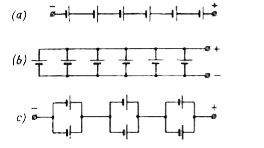The e.m.f. of one accumulator is e, its internal resistance is r. Find the e.m.f. ε and the internal resistance 
Ri of a battery of n accumulators connected (Fig. 26.10):
(a) in series,
(b) in parallel,
(c) in m series-connected groups of k accumulators, m<n.
k = n/m, where the accumulators are connected in parallel.
The correct Answer is:(a) ε=≠,Ri=nr; (b) ε=e;Ri=r/n;(c)ε=me,Ri=mr/k,=m2r/n.
(a) When the cells are connected in series, their e.m.f. and internal resistances are added.
(b) When the cells are connected in parallel, the e.m.f. remaias unchanged, but the internal conductances are added.
(c) in a mixed connection we calculate first the e.m.i. and the internal resistance of a group, and then the game parameters for the battery as a whole.
Similar Questions
The e.m.f. of one accumulator is e, its internal resistance is r. Find the e.m.f. epsi and the internal resistance R_(i) of a battery of n accumulators connected (Fig. 26.10): (a) in series, (b) in parallel, (c) in m series-connected groups of k accumulators, m lt n . k = n/m, where the accumulators are connected in parallel.
View SolutionBattery & E.M.F||Series & Parallel Connections
View Solutionn number of cells e.m.f of each is E and internal resistance is r connected in parallel or series combination and are connect to external resistance R.Same current flows through R in both cases. Then—
View SolutionIn the following circuit fig, a 10m long potentiometer wire with resistance 1,2 ohm/m, a resistance R_1 and an accumulator of e.m.f. 2V are connected in series. When the e.m.f. of thermocouple is 2.4 mV the deflection in galvanometer is zero. The current supplied by the accumulator will be
View SolutionA cell of e.m.f. E and internal resistance r is connected in series with an external resistance nr. Then, the ratio of the terminal potential difference to E.M.F. is
View Solutionn identical cells each of e.m.f. E and internal resistance r are connected in series. An external resistance R is connected in series to this combination. The current through R is
View SolutionN cells each of e.m.f. E & internal resistance r are grouped into sets of K cells connected in series. The (N/K) sets ae connected in parallel to a load of resistance R, then,
View Solution
